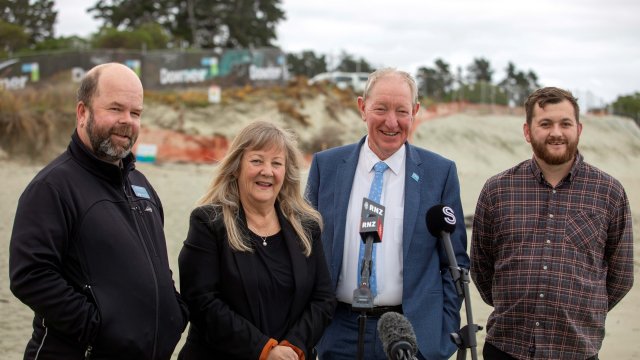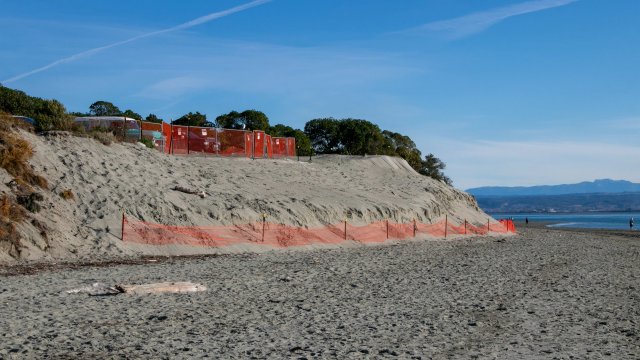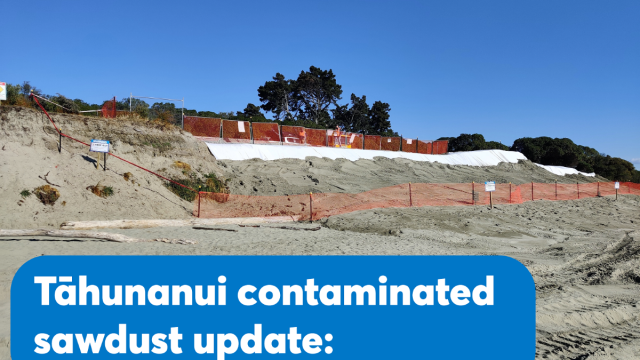Council seeking urgent remediation for contaminated sawdust at Tāhunanui's back beach
04/08/2023 12:34pmNelson City Council is seeking to urgently remediate and then remove contaminated sawdust found at Tāhunanui’s back beach after testing has confirmed the presence of concentrations of arsenic, chromium, copper and boron as well as dioxins, consistent with at least part of the sawdust and wood pieces being treated.
A request for $450,000 to carry out urgent short-term erosion mitigation work at the site to prevent further erosion of the sawdust into the environment and work to plan for the sawdust’s removal will be made at the upcoming 10 August Council meeting.
Nelson Mayor Nick Smith says it is clear from the latest test results the sawdust needs to be removed from Tāhunanui Beach.
“I am very disappointed that we have found toxins polluting Nelson’s precious Tāhunanui Beach and we have a duty to clean it up. The first step is to release the report outlining the findings of the testing and safeguard the affected area. Then we need to commission the expertise required to responsibly remove it. There is no place for contaminated wood waste in the fragile coastal environment of one of New Zealand’s most popular beaches.
“This problem arises from the dumping of wood waste in the 1960s when the toxicity of wood preservatives was poorly understood and when coastal areas were too often used for waste. It is frustrating to be having to spend ratepayers’ money on these sorts of legacy problems from poor historic environmental management. I have written to Government, seeking support from the Ministry for the Environment’s Contaminated Sites Remediation Fund to help ratepayers with the cost of dealing with this problem.
“The clean up will not be an easy task. There is estimated to be 5900 cubic metres of sawdust, and we are looking at several options for its disposal. Our most immediate actions will be to contain the already exposed sawdust and wood material and to protect beach users.”
Council initially understood the material was not considered a pollutant. Concerns were raised in 2022 about the exposure of the wood off-cuts within the sawdust and Council decided to begin testing the material for the possibility of contamination. Testing undertaken in May 2023 revealed some of the material had been chemically treated, and that the concentrations of arsenic, chromium, copper and boron exceeded the Australian and New Zealand Environment and Conservation Council (ANZECC) sediment quality guidelines and may represent a risk to the environment.
Last month, further tests to determine the extent and dimensions of the sawdust pile and confirm the presence of timber treatment chemicals found elevated concentrations of copper, chromium, arsenic and boron. In some instances, levels of arsenic were found to exceed NESCS standard (Ministry for the Environment (2011) Resource Management, National Environmental Standard for Assessing and Managing Contaminants in Soil to Protect Human Health) regulations for recreation land use.
The tests also revealed the presence of dioxins, which are considered toxic and associated with pentachlorophenol (PCP), a known wood preservative that is no longer used in New Zealand.
The car park at the back beach is safe to use within the fenced perimeter. The front face of the back beach car park is already taped off due to the risk of collapse due to erosion, and further fencing has been added to encompass all the exposed sawdust. The majority of the sawdust and wood waste is contained under the sealed car park and surrounding topsoil or sand, preventing direct human exposure, and the area of exposed sawdust along the foreshore is not easily accessible, or a place where prolonged exposure would occur.
Warning signs advising people to stay outside the fenced area are in place and additional signage warning that chemical contamination had been detected in the area were added on Friday. Members of the public are asked to heed the signs and avoid contact with the exposed sawdust.
Mayor Nick says: “We are taking a precautionary approach because it is a sensitive coastal environment and such a popular recreational area. I was involved as Minister for the Environment in setting the NESCS standards and they are rightly conservative about protecting public health and the environment. The greatest concern is that this contaminated material is in an area of active erosion and that is why we need to act quickly in minimising further environmental harm.”
Pending the outcome of Thursday’s Council meeting, work on a short-term remediation plan to contain the exposed sawdust will begin immediately.




